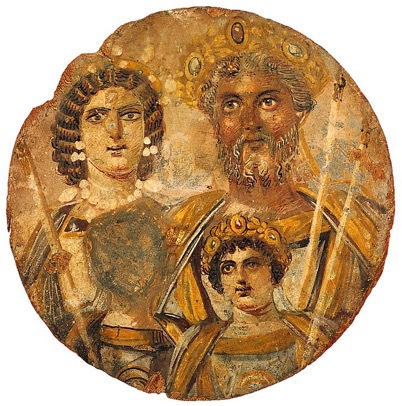Severan Family Tondo
Title
Date
Artist or Workshop
Materials
Height of the work
Provenience
Current Location
Sitter Biography
Description and Significance
Description: This tondo depicts Julia Domna, Caracalla, and Septimius Severus, three of the four members of the Severan dynasty of the Roman Empire. Their other son, Geta, was at one point also depicted on this tondo, but his face has been scrubbed out; the outline of his golden wreath can be seen around his destroyed face, and his neck, shoulders, and upper torso still remain. Julia Domna and Severus form the back row of the tondo, while the children Caracalla and Geta stand in the foreground. All four members of the family seem to be wearing the same clothing, with slight variations: every white garment includes two bands running down each shoulder down their respective arms, and a band across their collarbones, which, together with two more bands which begin at the shoulders and slope inwards towards their navels, forming an upside down triangle. The shoulders of Geta's garment are a deep maroon, matching the bands on his mother's robe, while every other vestment is white except for the bands of color. The bands on Geta's, Caracalla's, and Septimius Severus' drapery are gold, rather than maroon, and Caracalla and Geta have a downward-facing golden crescent on their garments as well, in the center of the “triangle”. Severus and his sons are also wearing the same golden wreaths, which have three precious stones in them; a crimson stone at the center of the wreath, and one white stone above each ear. All three of them hold white scepters which are topped with some golden ornamentation, but because of the damage to the tondo, it is difficult to discern what exactly lies at the top of the scepters. Julia Domna, standing in the back row on the left side of the tondo, is the only member of the family who is looking directly at the viewer, while Caracalla and Severus, forming the right column of the tondo, are looking off to their right, with their heads turned slightly upward. Between her thinner, brown-pupiled, eyes rests a short and thin nose, leading down to a small, yet warm smile that all of the members of the Severan family are giving to the viewer. Julia Domna is also wearing a pearl necklace and has an earring with three pearls on it on each ear, and her hair is braided into horizontal rows that run from her neck to the top of her head, on which rests a small crown with pearls on it. Caracalla's hair is brown, short, and curly, and like Julia Domna, he has a short, thin nose, but his eyes are rounder and shorter, like his father's. While Julia Domna, Caracalla, and the neck of Geta have a pale skin tone, Septimius Severus has a tanned complexion. His hair, both on top of his head and on his beard, has strands of both brown and gray. In spite of this, however, he has a rather youthful countenance, matching his wife and his son. His beard is kept trimmed, except for curls that lie below his chin.
Significance: This tondo represents an example of one of the most enduring trends in portraiture, extending from pharaonic Egypt through the Roman Empire: destroying artwork in order to promote a political agenda. In Egypt and in Rome, if a pharaoh or emperor was deemed to be dishonorable or to have brought misfortune to the state, their memory was expunged, both by chiseling out inscriptions, and by defacing and changing existing portraiture. In Egypt, two of the most prominent pharaohs who received this treatment were Akhenaten and Hatshepsut, and in Rome it was a fate that befell emperors, including Caligula, Nero, and Domitian, but also non-emperors, including Sejanus, prefect of Tiberius' Praetorian Guard. A modern term for this phenomenon in the Roman world is called damnatio memoriae. In this tondo, it is assumed that the young man with his face erased represents Geta, the brother of Caracalla whom Caracalla despised, had murdered, and issued a damnatio memoriae against. Similarly, Geta's name was removed from the Arch of Septimius Severus in Rome after he was assassinated. This tondo is also representative of contemporary painted portrait art in the Greco-Roman world. Various ancient authors view painting as the highest form of artistry in the Greco-Roman world, but unfortunately, the large majority of these paintings did not survive to the modern day. However, many of our surviving examples of this type of portraiture come from Egypt, where the dry climate preserved wooden objects, including mummy masks and this tondo. In fact, this tondo is the only extant painted representation of a Roman emperor.
References
Walker, S. (ed). 2000. Ancient Faces: Mummy Portraits from Roman Egypt, New York. pp. 14-25.
http://www.smb-digital.de/eMuseumPlus?service=ExternalInterface&module=collection&objectId=681547&viewType=detailView
Contributor
Citation
Item Relations
This item has no relations.

